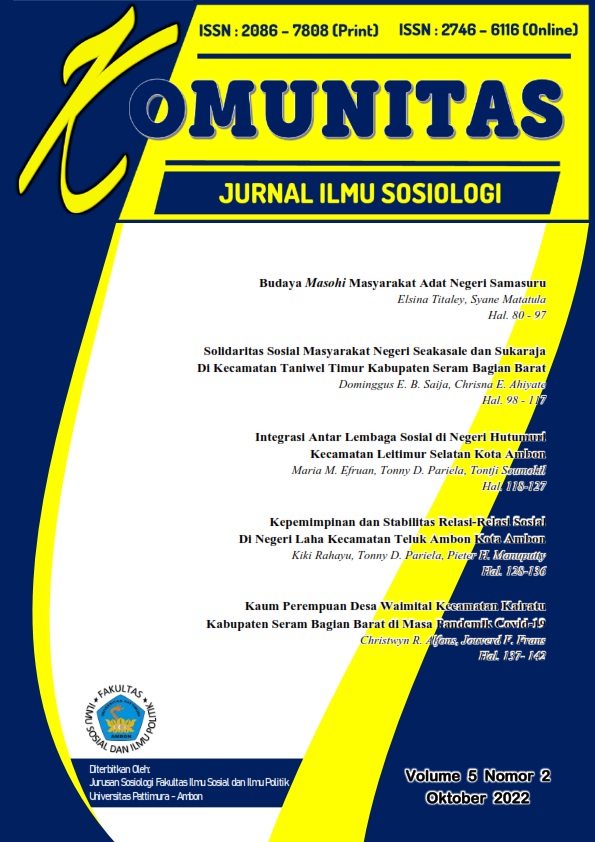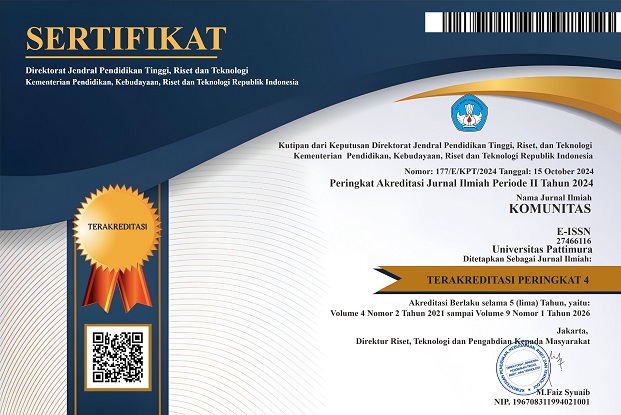BUDAYA MASOHI MASYARAKAT ADAT NEGERI SAMASURU - MALUKU
Abstract
Masyarakat Negeri Samasuru sebagai masyarakat adat di Maluku yang menempati wilayah selatan Pulau Seram, di dalamnya terdapat banyak nilai budaya yang dipraktekkan termasuk nilai budaya masohi. Juga, nama Samasuru digunakan sebagai nama lambang adat beberapa negeri adat di Pulau Saparua, Pulau Haruku, pulau Nusalaut dan Pulau Ambon. Melalui metode penelitian kualitatif deskriptif diketahui bahwa terdapat hubungan sosial berdasarkan sejarah dari negeri-negeri yang menggunakan nama Samasuru. Pelaksanaan budaya masohi oleh masyarakat Negeri Samasuru sangat bermanfaat bagi kepentingan jangka pendek maupun jangka panjang, dimana solidaritas sosial dalam masyarakat terus terbina bahkan mengalami peningkatan secara berkualitas. Saat ini pelaksanaan budaya masohi mengalami kelesuan oleh karena warga masyarakat telah memiliki fasilitas untuk menyelesaikan masalah pribadi, juga terbentuknya kelompok-kelompok di dalam masyarakat yang berkonflik sampai pada konflik fisik atas pengeruh pemerintah sebagai akibat sengketa batas wilayah kabupaten antara Kabupaten Maluku Tengah dengan Kabupaten Seram Bagian Barat.
Kata Kunci: Budaya, masohi, Samasuru, solidaritas sosial, konflik.
The Samasuru village community is an indigenous community in Maluku which occupies the southern region of Seram Island, in which many cultural values that are practised including masohi cultural values. Also, the name Samasuru is used as the name of the traditional symbol of several indigenous villages on Saparua Island, Haruku Island, Nusalaut Island and Ambon Island. Through descriptive qualitative research methods, it is known that there are social relations based on the history of countries that use the name Samasuru. The implementation of masohi culture by the people of Samasuru village is very beneficial for both short and long-term interests, where social solidarity in society continues to be fostered and even increases in quality. At present, the implementation of masohi culture is experiencing sluggishness because members of the community already have the facilities to resolve personal problems, as well as the formation of groups within the community that are in conflict to the point of physical conflict over the influence of the government as a result of a district boundary dispute between Central Maluku Regency and Seram Regency.
Keywords: Culture, masohi, Samasuru, social solidarity, conflict.
Downloads
References
Adluri, S. (2019). Viewing Telugu Inscriptions at Ahobila. South Asian Studies, 35(2), 168–180. https://doi.org/10.1080/02666030.2019.1641968
Aureli, F., & Schino, G. (2019). Social complexity from within: how individuals experience the structure and organization of their groups. Behavioral Ecology and Sociobiology, 73(1). https://doi.org/10.1007/s00265-018-2604-5
Bernstein, M. J., Zawadzki, M. J., Juth, V., Benfield, J. A., & Smyth, J. M. (2018). Social interactions in daily life: Within-person associations between momentary social experiences and psychological and physical health indicators. Journal of Social and Personal Relationships, 35(3), 372–394. https://doi.org/10.1177/0265407517691366
Chua, A. (2002). The influence of social interaction on knowledge creation. Journal of Intellectual Capital, 3(4), 375–392. https://doi.org/10.1108/14691930210448297
Ellen, R. (2019). Pottery production and trade in the Banda zone, Indonesia: The Kei tradition in its spatial and historical context. Indonesia and the Malay World, 47(138), 133–159. https://doi.org/10.1080/13639811.2019.1582862
Gallelli, A. (2016). Social Structure and Cultural Production: An Empirical Analysis of Festivals’ Networks. Journal of Arts Management Law and Society, 46(1), 34–46. https://doi.org/10.1080/10632921.2015.1131217
Gasteyer, S., & Araj, T. (2009). Empowering Palestinian Community Water Management Capacity: Understanding the Intersection of Community Cultural, Political, Social, and Natural Capitals. Community Development, 40(2), 199–219. https://doi.org/10.1080/15575330903012288
Griffiths, A. (2021). The sanskrit inscription of śankara and its interpretation in the national history of Indonesia. Bijdragen Tot de Taal-, Land- En Volkenkunde, 177(1), 1–26. https://doi.org/10.1163/22134379-bja10014
Hallmann, K., Rossi, L., Breuer, C., & Ilgner, M. (2020). Determinants of public perception of elite sport. International Journal of Sport Policy and Politics, 12(3), 439–453. https://doi.org/10.1080/19406940.2020.1794930
Idang, G. E. (2018). African Culture and Values. Phronimon, 16(2), 97–111. https://doi.org/10.25159/2413-3086/3820
Jaysawal, N. (2013). Civil society, Democratic space, And social work. SAGE Open, 3(4). https://doi.org/10.1177/2158244013504934
Kuo, M.-M., & Lai, C.-C. (2006). Linguistics across Cultures: The Impact of Culture on Second Language Learning. Online Submission, 1(1), 1–10.
Li, Y. Q., & Liu, C. H. (2019). The power of coworkers in service innovation: the moderating role of social interaction. International Journal of Human Resource Management, 30(12), 1956–1976. https://doi.org/10.1080/09585192.2017.1314310
Litt, E., Zhao, S., Kraut, R., & Burke, M. (2020). What Are Meaningful Social Interactions in Today’s Media Landscape? A Cross-Cultural Survey. Social Media and Society, 6(3). https://doi.org/10.1177/2056305120942888
Lyvers, M., Hanigan, C., & Thorberg, F. A. (2018). Social Interaction Anxiety, Alexithymia, and Drinking Motives in Australian University Students. Journal of Psychoactive Drugs, 50(5), 402–410. https://doi.org/10.1080/02791072.2018.1517228
Mansyur, S. (2005). Permukiman Tradisional Masyarakat Tanimbarkei. Kapata Arkeologi, Vol. 1(No. 1, Agustus), 70–87. https://doi.org/http://dx.doi.org/10.24832/kapata.v1i1.17
Nadler, J. (2017). Expressive Law, Social Norms, and Social Groups. Law and Social Inquiry, 42(1), 60–75. https://doi.org/10.1111/lsi.12279
O’Connell, B. H., O’Shea, D., & Gallagher, S. (2016). Enhancing social relationships through positive psychology activities: a randomised controlled trial. Journal of Positive Psychology, 11(2), 149–162. https://doi.org/10.1080/17439760.2015.1037860
Qiong, O. U. (2017). A Brief Introduction to Perception. Studies in Literature and Language, 15(4), 18–28. https://doi.org/10.3968/10055
Rajapaksa, D., Islam, M., & Managi, S. (2018). Pro-environmental behavior: The role of public perception in infrastructure and the social factors for sustainable development. Sustainability (Switzerland), 10(4). https://doi.org/10.3390/su10040937
Yamin, P., Fei, M., Lahlou, S., & Levy, S. (2019). Using social norms to change behavior and increase sustainability in the real world: A systematic review of the literature. Sustainability (Switzerland), 11(20). https://doi.org/10.3390/su11205847


2.png)










.png)

